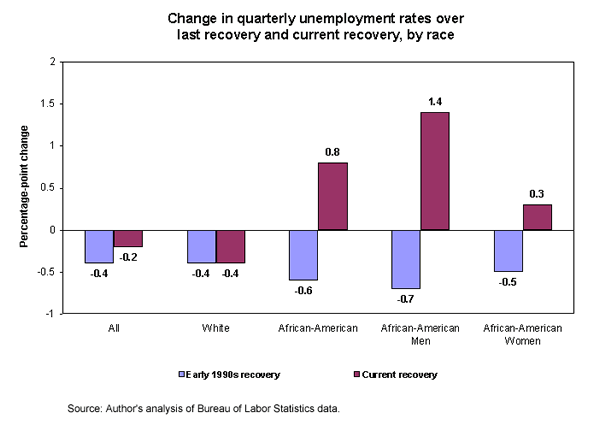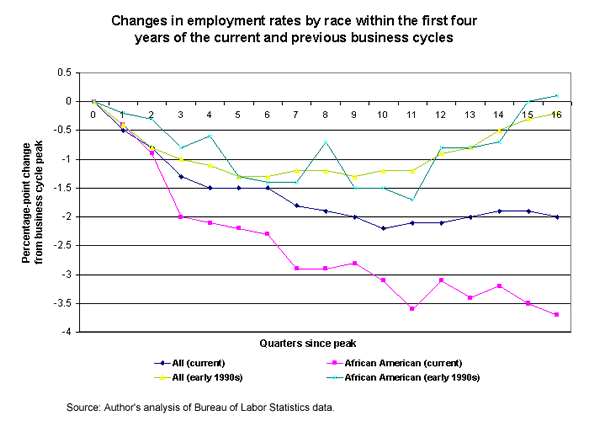See Snapshots Archive.
Snapshot for April 6, 2005.
African Americans in the current recovery
Recent employment reports reveal consistent increases in hiring, providing evidence that the jobless recovery is finally behind us. Yet, while many indicators have begun trending in the right direction, the labor market fortunes of African Americans continue to lag behind.
The charts below focus on two indicators of labor market conditions by race: unemployment and employment rates. We also provide a comparison between current conditions and those of the “jobless recovery” of the early 1990s. The data reveal that African Americans are doing worse than others in this recovery, and are faring worse than they did in the 1990s recovery.
The first chart shows the change in unemployment rates by race and gender over two time periods: the first 13 quarters of this recovery and the same time period over the early 1990s recovery. While the overall rate (i.e., the rate for all jobseekers) and the white rate specifically both fell by 0.4 percentage points in the first three years of the early 1990s recovery, the rate fell slightly faster, by 0.6 points, for African Americans. This relationship is the long-held historical pattern for minorities, as their employment opportunities tend be more responsive than whites to changes in economic conditions (e.g., minority unemployment rates tend to worsen faster in a downturn and improve more quickly in an expansion, where as white rates tend to be more stable).

Surprisingly, in this recovery, the opposite pattern has prevailed thus far. The overall rate is down slightly, as is the white rate. But the unemployment rate for African Americans is up by 0.8 percentage points overall, driven by the 1.4 point increase for African American men. By the first quarter of 2005, the overall African American unemployment rate was 10.6%, while the overall rate–5.3%–was half that level.
Employment–as opposed to unemployment–rates offer another useful means of measuring labor market performance. Employment rates show the share of a given group that is working, and as such, provide a simple proxy for labor demand for different types of workers. The second chart plots the changes in this measure relative to the quarter the recession began (traditionally known as the business cycle ‘peak’) through the most recent quarter for which we have these data (2005q1). Note that in both of the last two recessions, employment rates fell as labor demand underwent a cyclical contraction.

But conspicuous differences are apparent between the last two business cycles. In the early 1990s, the overall employment rate began to climb by around the 10th quarter, and the African American rate follows the overall rate fairly closely. In the current case, however, employment rates have yet to trend up very convincingly, and African American rates actually have continued to fall. Almost four years after the recession began in March 2001, employment rates remain down by 2 percentage points overall and almost twice that much (3.7 points) for African Americans.
The reasons for these racial disparities are not yet known, but a few likely suspects are:
- * labor demand remains relatively weak for this stage of a recovery, and this has a greater impact on minorities;
- * there are weaknesses remaining in the particular industries and occupations where African Americans (men, in particular) are over represented, such as manufacturing; and
- * the labor market still discriminates against minorities, particularly African American males.
This week’s Snapshot was written by EPI economist Jared Bernstein with research assistance by Yulia Fungard.
